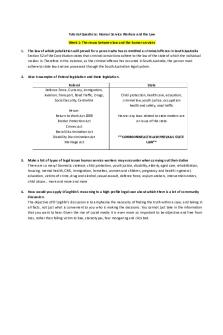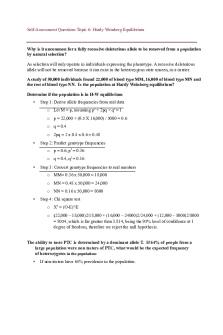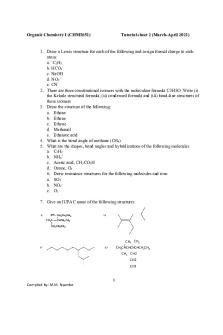HC-HFO-Manual - tutorial PDF

| Title | HC-HFO-Manual - tutorial |
|---|---|
| Author | efrain Her |
| Course | The Air Force Today |
| Institution | University of Florida |
| Pages | 95 |
| File Size | 2.9 MB |
| File Type | |
| Total Downloads | 74 |
| Total Views | 167 |
Summary
tutorial...
Description
Techniques and Regulations for the Safe Handling of Flammable Hydrocarbon and Hydrofluoroolefin Refrigerants Written by Kay Rettich Julia Setlak Robert P. Scaringe, Ph.D., P.E.
Second Edition February 2017
© Copyright 2017 ALL RIGHTS RESERVED Mainstream Engineering Corporation, Rockledge, Florida
Except as permitted by Sections 107 and 108 of the 1976 United States Copyright Act, no part of this publication may be reproduced or distributed in any form, or by any means, or stored in any database or retrieval system, without the prior written permission of the copyright owner. Information contained in this work has been obtained by Mainstream Engineering Corporation from sources believed to be reliable. However, neither Mainstream Engineering Corporation nor its authors guarantee the accuracy or completeness of any information published herein, and neither Mainstream Engineering Corporation nor its authors shall be responsible for any errors, omissions, or damages arising out of the use of this information. This work is published with the understanding that Mainstream Engineering Corporation and its authors are supplying information but are not attempting to render engineering or other professional or technical services. If such services are required, the assistance of an appropriate professional should be sought. These standards and codes of practice are current at the time of publishing. You should check to ensure they are still current.
Table of Contents Preface ..................................................................................................................................... vii Safety Precautions .................................................................................................................... vii EPA Regulations ....................................................................................................................... vii Liability ...................................................................................................................................... vii Document Conventions .............................................................................................................. ix Chapter 1.
What Are Hydrocarbon Refrigerants? ................................................................. 1
Physical Properties of Hydrocarbons...................................................................................... 2 HC Refrigerant Types ............................................................................................................ 2 R-600a (Isobutane) ............................................................................................................ 2 R-290 (Propane)................................................................................................................. 4 R-441a ............................................................................................................................... 4 R-1270 ............................................................................................................................... 5 Other HC Blends ................................................................................................................ 5 Materials Compatibility ........................................................................................................... 5 Lubricants........................................................................................................................... 5 Desiccants.......................................................................................................................... 6 Materials............................................................................................................................. 6 Chapter 2.
What Are Hydrofluoroolefin Refrigerants? ........................................................... 8
HFO Refrigerant Types .......................................................................................................... 9 R-1234yf............................................................................................................................. 9 R-1234zd...........................................................................................................................10 R-1234ze...........................................................................................................................10 R-449B ..............................................................................................................................14 Materials Compatibility ..........................................................................................................15 Lubricants..........................................................................................................................15 Desiccants.........................................................................................................................15 Materials............................................................................................................................15 Chapter 3.
Environmental Comparison of HC, HFO, and HFC Refrigerants ........................17
Global Warming Potential......................................................................................................18 Ozone-Depleting Potential ....................................................................................................18 Temperature Glide ................................................................................................................18 Saturation Pressure–Temperature Behavior of HC and HFO Refrigerants ............................19 Chapter 4.
What is the EPA SNAP Program?......................................................................21
Background and History of the SNAP Program .....................................................................21 EPA Rule on Refrigerants .....................................................................................................23
iii
Covered End Uses ................................................................................................................24 Household Refrigeration ....................................................................................................24 Retail Food Refrigerators and Freezers.............................................................................24 Other Use Conditions ............................................................................................................25 Charge Size Limitations ........................................................................................................25 Color-Coded Hoses and Piping .............................................................................................26 Labeling ................................................................................................................................27 Refrigerant Containers ..........................................................................................................27 Refrigerant Container Colors.................................................................................................27 Unique Fittings ......................................................................................................................28 Training Requirements ..........................................................................................................28 Recovery and Recycling Equipment......................................................................................29 Chapter 5.
What are the Safety Classifications of HC and HFO Refrigerants? ....................30
ASHRAE Safety Classifications.............................................................................................30 Toxicity ..............................................................................................................................30 Flammability ......................................................................................................................32 Flammability Limits of Hydrocarbon Refrigerants ..................................................................32 Use Conditions......................................................................................................................33 Asphyxiation..........................................................................................................................34 Chapter 6.
What are the HC and HFO Safe Handling Practices? ........................................36
Charge Limitations ................................................................................................................36 Household Refrigeration ....................................................................................................36 Retail Food Refrigeration...................................................................................................37 HC and HFO Refrigerant Recovery .......................................................................................37 Recovery Techniques........................................................................................................37 Identifying the Refrigerant .................................................................................................37 Evacuation Requirements .................................................................................................39 Proper Recovery/Recycling Equipment .............................................................................40 Pressure Decay Leak Test ................................................................................................44 Triple Evacuation...............................................................................................................46 Triple Evacuation Procedure .............................................................................................47 Leak Repairs .........................................................................................................................52 Brazing..................................................................................................................................52 Pipe Connections ..............................................................................................................52 Charging ...............................................................................................................................53 Liquid Charge ....................................................................................................................53 Recharging the System with Recovered Refrigerant..........................................................53 Venting..................................................................................................................................54 Static Electricity Concerns.....................................................................................................55
iv
Handling................................................................................................................................55 Sales Restrictions .................................................................................................................56 MVAC Self-sealing Valve Specifications ...............................................................................58 Shipping ................................................................................................................................58 Department of Transportation Regulations ........................................................................58 Shipping Labels .................................................................................................................58 Cylinder Loading ...............................................................................................................59 Storage .................................................................................................................................59 Risk Assessment ...............................................................................................................59 Major Accident Prevention Policy ......................................................................................60 Procedures for Damaged Equipment.................................................................................60 Record Keeping Procedures .................................................................................................61 Chapter 7.
Summary ...........................................................................................................62
End Use 1 .............................................................................................................................62 Substitute Refrigerants ......................................................................................................62 Use Conditions ..................................................................................................................62 Safety Information .............................................................................................................62 Permanent Markings .........................................................................................................63 End Use 2 .............................................................................................................................65 Substitute ..........................................................................................................................65 Use Conditions ..................................................................................................................65 Permanent Markings .........................................................................................................65 UL References ......................................................................................................................65 End Use 3 .............................................................................................................................66 Substitute Refrigerants ......................................................................................................66 End Use 4 .............................................................................................................................66 End Use 5 .............................................................................................................................66 End Use 6 .............................................................................................................................67 Chapter 8.
Acronyms...........................................................................................................68
Chapter 9.
Definitions ..........................................................................................................71
References ...............................................................................................................................80 Index .........................................................................................................................................83
v
vi
Preface The information in this course is intended for educational purposes only. Procedures described in this manual are for use only by qualified air conditioning and refrigeration service technicians who already hold EPA Section 608 Type II, Type III, or Universal Certification. This training course is not a substitute for the operator manual of any equipment manufacturer.
Safety Precautions Take safety precautions when using all HVAC equipment. Improper use of HVAC equipment can cause explosion and serious personal injury. Always read the entire manufacturer’s operator manual before turning on any equipment for the first time. Never turn on any equipment if you do not understand its operation. Where procedures described in this manual differ from those of a specific equipment manufacturer, you should follow the equipment manufacturer’s instructions. Use caution when working with hydrocarbon refrigerants; hoses could contain liquid flammable refrigerant under pressure. Use only approved refillable storage cylinders. Do not overfill any storage cylinder beyond its rated capacity. Always wear safety glasses. Protect the skin from flash freezing. Do not leave any refrigerant recovery or recovery–recycling machine on and unsupervised. For flammable refrigerants, never use any equipment that is not rated to handle flammable refrigerants. All refrigerant recovery and recycling devices are to be used by trained refrigeration technicians only. Misuse of refrigerant recovery and recycling devices can cause explosion and personal injury.
EPA Regulations Technical and legislative information presented in this book is current as of the date of the manual’s latest publication. Because of rapidly advancing technology and changing regulations in the hydrocarbon refrigerant area, no representation can be made for the future accuracy of the information. Visit the EPA’s Internet home page at http://www.epa.gov for the latest details.
Liability Mainstream Engineering Corporation assumes no liability for the use of information presented in this publication. This information is presented for educational purposes only.
vii
Manufacturer’s operator manuals must be consulted for the proper operation of any piece of equipment. The content of this course is limited to information and service practices needed to contain, conserve, and re-use flammable refrigerants, and to prevent their escape into the atmosphere. This manual is not intended to teach air conditioning–refrigeration system installation, safety, troubleshooting, or repair. Refrigeration technicians should already be well versed in these areas before taking this course.
viii
Document Conventions The following helpful information appears throughout this document:
Caution Cautions indicate the possibility of bodily harm or damage to your equipment.
Note Notes contain related information.
Tip Tips are designed to provide hints or shortcuts.
Example Examples provide practical applications of a concept.
ix
Chapter 1. What Are Hydrocarbon Refrigerants? A hydrocarbon is an organic compound consisting only of carbon and hydrogen atoms. A halocarbon is any compound derived from a hydrocarbon by replacing at least one hydrogen atom with a halogen. For halocarbon hydrofluorocarbon (HFC) refrigerants, some of the hydrogen atoms are replaced with fluorine atoms. Although the fluorine atoms reduce the flammability of the refrigerants, the fluorine is harmful to the environment. The hydrocarbon refrigerants are therefore flammable (because the hydrogen atom has not been replaced with a halogen such as fluorine). Hydrocarbon (HC) refrigerants are classified as American Society of Heating, Refrigerating and Air-Conditioning Engineers (ASHRAE) safety group A3, meaning they have low toxicity and are highly flammable.
Figure 1. Refrigerant safety group classification
1
Physical Properties of Hydrocarbons Hydrocarbon refrigerants are components of oil and natural gas that are found in nature. Although hydrocarbon refrigerants have excellent environmental, thermodynamic, and thermo-physical properties, these refrigerants are highly flammable. Table 1 summarizes the physical properties of hydrocarbons [ACRIB, 2001]. Table 1. Physical Properties of HC Refrigerants
ASHRAE Number
Chemical Name
Molecular Formula
Normal Boiling Point or Bubble/Dew Points (°F) at 1atm
R-600a
Isobutane
C4H10
10.9
274.4
513.2
R-601a
Isopentane
C5H12
81.9
370...
Similar Free PDFs

Tutorial
- 17 Pages

Tutorial-4 - Tutorial Problems
- 3 Pages

BFW2401-Tutorial 8 - Tutorial
- 2 Pages

Tutorial
- 2 Pages

203-tutorial-9 - Tutorial 9
- 4 Pages

Radiation tutorial
- 3 Pages

Tutorial Questions
- 15 Pages

VisiRule Tutorial
- 42 Pages

Tutorial 1
- 4 Pages

Tutorial-2
- 1 Pages

Genetics Tutorial
- 5 Pages

Vivado tutorial
- 24 Pages
Popular Institutions
- Tinajero National High School - Annex
- Politeknik Caltex Riau
- Yokohama City University
- SGT University
- University of Al-Qadisiyah
- Divine Word College of Vigan
- Techniek College Rotterdam
- Universidade de Santiago
- Universiti Teknologi MARA Cawangan Johor Kampus Pasir Gudang
- Poltekkes Kemenkes Yogyakarta
- Baguio City National High School
- Colegio san marcos
- preparatoria uno
- Centro de Bachillerato Tecnológico Industrial y de Servicios No. 107
- Dalian Maritime University
- Quang Trung Secondary School
- Colegio Tecnológico en Informática
- Corporación Regional de Educación Superior
- Grupo CEDVA
- Dar Al Uloom University
- Centro de Estudios Preuniversitarios de la Universidad Nacional de Ingeniería
- 上智大学
- Aakash International School, Nuna Majara
- San Felipe Neri Catholic School
- Kang Chiao International School - New Taipei City
- Misamis Occidental National High School
- Institución Educativa Escuela Normal Juan Ladrilleros
- Kolehiyo ng Pantukan
- Batanes State College
- Instituto Continental
- Sekolah Menengah Kejuruan Kesehatan Kaltara (Tarakan)
- Colegio de La Inmaculada Concepcion - Cebu



